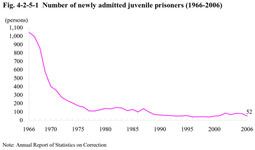| Previous Next Index Image Index Year Selection | |
|
|
1 Number and characteristics of juvenile prisoners
Among newly admitted prisoners, the number of those who were under 20 years of age at the time of admittance (including those who were over 20 at the time of admittance but were under 20 when receiving an indeterminate sentence; hereinafter referred to as “newly admitted juvenile prisoners”) was over 1,000 in 1966, but decreased after that, remaining below 100 since 1988. In 2006, 52 juveniles (a decrease of 29 juveniles from the previous year) were imprisoned including 1 female.
Fig. 4-2-5-1 shows the shift in the number of newly admitted juvenile prisoners since 1966. Fig. 4-2-5-1 Number of newly admitted juvenile prisoners (1966-2006) Among juvenile prisoners newly admitted in 2006 (those who were over 20 at the time of admittance but were 19 when receiving an indeterminate sentence are considered to be 19), 5 juveniles were aged 16 or 17 and 47 juveniles were aged 18 or 19. There were no juvenile prisoners under 16 at the time of admittance from 2001 after the amendment of the Juvenile Act in 2000 to 2006.Among 52 newly admitted juvenile prisoners in 2006, 1 was sentenced to life imprisonment, three to imprisonment for a fixed term for over 10 years but 15 years or less, 25 to imprisonment for an indeterminate term for over five years but 10 years or less; the upper limit term is adopted in the case of an indeterminate sentence, 15 to imprisonment for an indeterminate term for over three years but five years or less, and 8 received indeterminate sentences for three years or less. By type of sentence, 49 juveniles were sentenced to imprisonment with work, and 3 were sentenced to imprisonment without work. By type of offense, robbery was largest in number with 17 (3 for robbery, 11 for robbery causing death or injury, and 3 for rape on the occasion of robbery causing death), followed by injury with 7 (2 for injury and 5 for injury causing death), negligence in the pursuit of social activities with 7, and homicide with 5 (Source: Annual Report of Statistics on Correction). |
